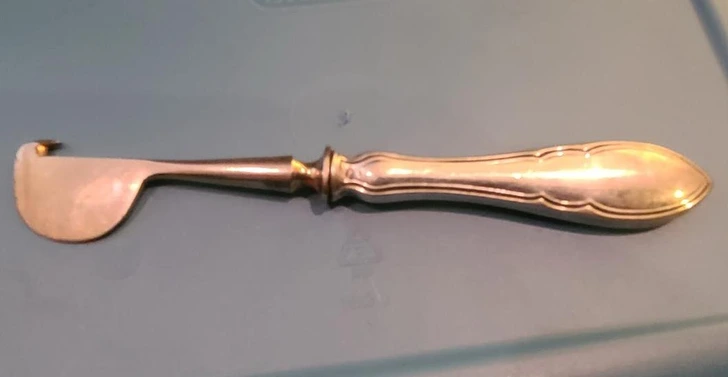I found this in an old silverware set. It’s a little shorter than a teaspoon, and the bottom edge is not sharp at all.
 Answer: This is a citrus peeler for oranges, grapefruits, lemons, limes, etc.
Answer: This is a citrus peeler for oranges, grapefruits, lemons, limes, etc.
This antique-looking piece of flatware is actually a citrus peeler, designed for fruits like oranges, grapefruits, lemons, and limes. Unlike knives, it doesn’t need to be sharp because its purpose isn’t slicing — it’s peeling.
How It Works
- The curved hook at the end is used to score the peel of the fruit without cutting too deeply into the flesh.
- Once the peel is scored, you can easily slide your fingers under the skin and remove it in sections.
- The blunt edge ensures safety and makes it easy to use, even for children.
Why Citrus Peelers Were Popular
- Table Etiquette: In the 19th and early 20th centuries, fruit was often served at formal dining tables. Proper utensils, like citrus peelers, allowed guests to peel fruit neatly without using their fingers.
- Durability: Made from silver or stainless steel, these tools were long-lasting and often came in elegant flatware sets.
- Convenience: They made peeling citrus fruits faster, cleaner, and more refined compared to using just a knife.
Common Misconceptions
- It’s not a butter knife (too small, wrong shape).
- It’s not a cheese slicer (the edge isn’t sharp).
- It’s not a shoe tool or random decoration — it really had a practical dining purpose.
Final Thoughts
That curious little utensil you found in your silverware set is a citrus peeler — a once-common but now rare tool for neatly peeling oranges, grapefruits, and other citrus fruits at the table.
While modern households may not use them often anymore, they remain a fascinating piece of dining history and a charming reminder of when table manners and specialized utensils were taken very seriously.
Beta feature


